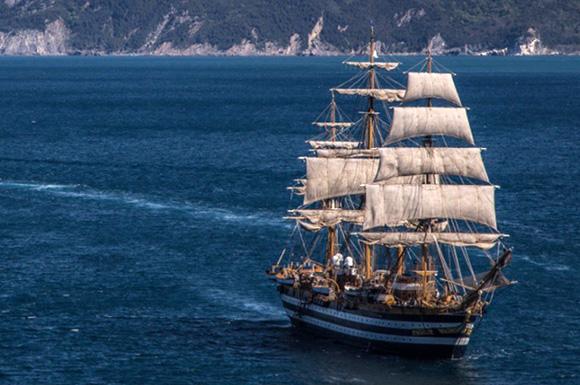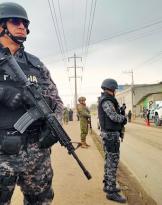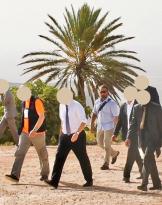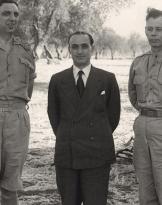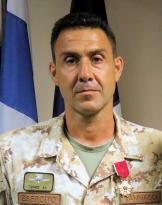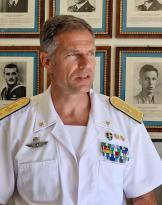As I finish writing this interview, theAmerigo Vespucci, Navy school ship, has just sailed to Madeira, the small Portuguese island that smells of flowers and subtropical winds: in front of her only the Atlantic. In the immense beauty of its white expelled sails, it plows the waves of the ocean to bring back a century of Italian seafaring history and tradition to the north of the Americas after seventeen years. Defense Online has reached the commander, captain of vessel Angelo Patruno.
What is it like to command the most beautiful ship in the world?
To command what was defined in 1962 by the American aircraft carrier USS Independence as "the most beautiful ship in the world" is an honor and a privilege. As a young student, boarding the Vespucci for the first time, I happened to think that one day being in charge of this unit would be the crowning of a dream for me. Today, thinking back to those moments, I relive a great emotion and feel even stronger the sense of gratitude and belonging to the Navy that gave me this great and unique opportunity. The Amerigo Vespucci has always been considered a priceless jewel of the Italian heritage and of the Navy: since 1931 its task has been to train and train future sailors and officers of our Armed Force through a very strong multiplier of values represented by the combination of tradition represented by the ancient seafaring art practiced aboard sailing ships and the technological innovation of modern navigation and communication instruments.
She was a pupil on this ship and returned aboard as a commander. How did your career develop?
 I finished the Naval Academy of Livorno in 89, leaving it with the rank of ensign. At the end of the "Naval Artillery" course in 1990, I served as "weapons officer" first on the cruiser Andrea Doria and then on the corvette Chimera as "operations department chief". In the years 1997 and 1998 I was the commander of the Tremiti auxiliary unit, then I served on the Lupo and Perseo frigates. After being assigned at the Aeronavale Training Center of Taranto as an instructor officer of the Weapons Component, I then held the role of commander of the courses at the NCO school. In 2006/2007 I commanded a first sailing unit, the Palinuro training ship and subsequently I held the role of "tactical training department head" at the Navy Training Center. I then served for five years at NATO's “Command of Italian Maritime Forces” before coming to command of Amerigo Vespucci on 4 October 2016.
I finished the Naval Academy of Livorno in 89, leaving it with the rank of ensign. At the end of the "Naval Artillery" course in 1990, I served as "weapons officer" first on the cruiser Andrea Doria and then on the corvette Chimera as "operations department chief". In the years 1997 and 1998 I was the commander of the Tremiti auxiliary unit, then I served on the Lupo and Perseo frigates. After being assigned at the Aeronavale Training Center of Taranto as an instructor officer of the Weapons Component, I then held the role of commander of the courses at the NCO school. In 2006/2007 I commanded a first sailing unit, the Palinuro training ship and subsequently I held the role of "tactical training department head" at the Navy Training Center. I then served for five years at NATO's “Command of Italian Maritime Forces” before coming to command of Amerigo Vespucci on 4 October 2016.
Sailing - sailing - on a ship of the other century ... What emotions do you feel in this combination of history, tradition and modernity?
Nave Vespucci is the oldest unit of the Navy, and traditions are an essential element for the life of the ship itself: the element that most distinguishes the training value of the Vespucci is the fusion of two apparently different aspects but which together contribute to the professional and human growth of students. On the one hand, in fact, they will have to learn how to navigate on a sailing ship using methods used in the last century: trace a course by studying the winds, observe the stars with the sextant to determine their position at sea, maneuver the sails by climbing the masts and flagpoles; on the other hand, one also learns to use GPS, Radar, to use satellite communications and the most advanced technology today offers us, which will then be the world they will be immersed in when they serve on our ultra-modern units.
Living on this ship is a continuous journey through time, with a firm hand on the past but always looking to the future.
Nave Vespucci took the sea last 19 April, how was the first week of navigation for volunteer students?
The 79 students of the 24 ° Volunteer course in Preliminary Quadrennial Stop (VFP4) have faced these first 8 days of navigation with extreme passion and interest. This first navigation was a true baptism of the sea for them; they have been completely absorbed by the rhythms of this ship punctuated by the tolling of the bell at the center of the ship as it happened two centuries ago; they have also learned to know her, to walk along its corridors in a casual way, to become part of the ship's permanent crew, living their own rhythms and carrying out their own activities, basically to love her. Finally, they also had the privilege of crossing the Pillars of Hercules, an event not so frequent and therefore reserved for a few sailors.
 Can you tell us an anecdote?
Can you tell us an anecdote?
Nave Amerigo Vespucci has a history of more than 80 years, so you can imagine how many stories to tell. But I like to remember the period when the ship was commanded by one of my myth and an absolute legend of Italian sailing as the admiral Agostino Straulino. Apart from the most famous anecdotes about its incredible passage of the navigable canal of Taranto to sailing, rather than its historical rise of the Thames always in full sail, not everyone knows that crossing the Strait of Gibraltar en route to northern Europe in the summer of the 1965, the control station at the passage of the ship signaled to flashes of light as established procedure: "What Ship ????"
The admiral, resented by this inadmissible lack of knowledge, made respond to flashes of light from the bridge of Vespucci: "What Rock ????"
How is the students' day of navigation punctuated?
The life of the students on Nave Vespucci is very demanding. Each, in turn, performs an on-call service that provides for the carrying out and learning of an on-board activity relating to its category of belonging; the services performed range from assisting the personnel of the bridge to assist the technicians of the engine room to be part of the helmets teams for the rudders at the helm. In addition, there are periods of theoretical lessons in navigation and meteorology as well as professional and historical-cultural briefings. Added to this are the "maneuvering places" during which all the students, climbing in trees, are an integral part of the crew of Nave Vespucci for maneuvering the sails.
The first stop was in Portugal, in Sines, why?
Sines represents the first stage of the Tall Ship Race, the historic international regatta that annually sees the "giants of the sea" compete. The goal of Tall Ships Races has always been to keep the tradition of sailing alive, especially among the new generations. ; objective that fully converges with the Navy's desire to train its men and women with a common base and values represented by being a sailor and loving and respecting the precious "blue" element, the future protagonist of one's professional career. in Sines, the unit will head to Funchal on the island of Madeira.
The 10 may sail from Madeira to the islands of Bermuda, a long navigation that will put a strain on the crew and the students. What are the peculiarities of this route?
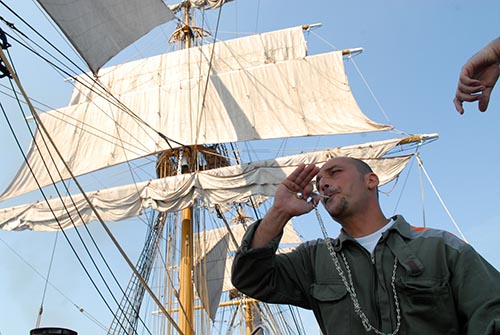
The peculiarity lies precisely in the long ocean crossing of about 20 days; in the imagination of any sailor, crossing the ocean by sail has always been a stimulus and a goal to be achieved. It is in fact this incredible and unique experience and opportunity that will allow future sailors to forge in the soul and physique, who through sailing temper their character and learn the absolute value of the crew, teamwork and the spirit of service. individual and collective.
"Not who starts, but what perseveres" the motto of the Vespucci; an illuminating phrase carried by sea from the emblem of our Navy and ambassador of Italianness. In the so-called "blue century" in which sustainable development passes through maritime businesses, the driving force of the global economy, how does Nave Vespucci's persevering naval diplomacy move towards the countries that will be touched?
The Amerigo Vespucci School ship is the emblem and symbol of the Navy. It contains the founding values of the Armed Force, but not only. There is also the excellence of Made in Italy, the attention to detail, the attention to the ancient and noble maritime traditions; there is also a strong Italian cultural dimension, based on respect and solidarity.
Nave Vespucci and the other sailing units of the Navy employed for training are real ambassadors of the country with the task of representing Italy and the prestige of the Armed Forces abroad through the organization of cultural and promotional events in collaboration with national diplomatic representations in host countries. They also contribute to the dissemination of important environmental issues in collaboration with various associations in order to transmit and convey respect for our ecosystem and spread the culture for the sea.
Nave Vespucci's 2017 Education Campaign reflects a broader international, European and global vision that outlines the beginning of the millennium as a "blue century". "Blue growth" is considered an indispensable factor on which to aim for a sustainable development of our country in a context where maritimeity is a fundamental resource for commercial, occupational and technological growth.
The presence of Nave Vespucci in the North American area will allow the consolidation of diplomatic and social relations in an area of unusual gravitation for the Italian Navy, where the bond with our country is very strong due to the presence of a large and important community of compatriots. The stops of this educational campaign will see the ship involved in major activities such as the celebrations of the 150th anniversary of the Canadian Confederation and participation in the Tall Ship Race. The ship can be visited in every port: it is an opportunity to bring both the Italian communities on board, including the local representatives of the National Sailors of Italy, and to consolidate contacts with local communities. Finally, the ship is the Goodwill Ambassador of UNICEF Italy and carries with it a message of peace and hope for the millions of children that UNICEF helps.
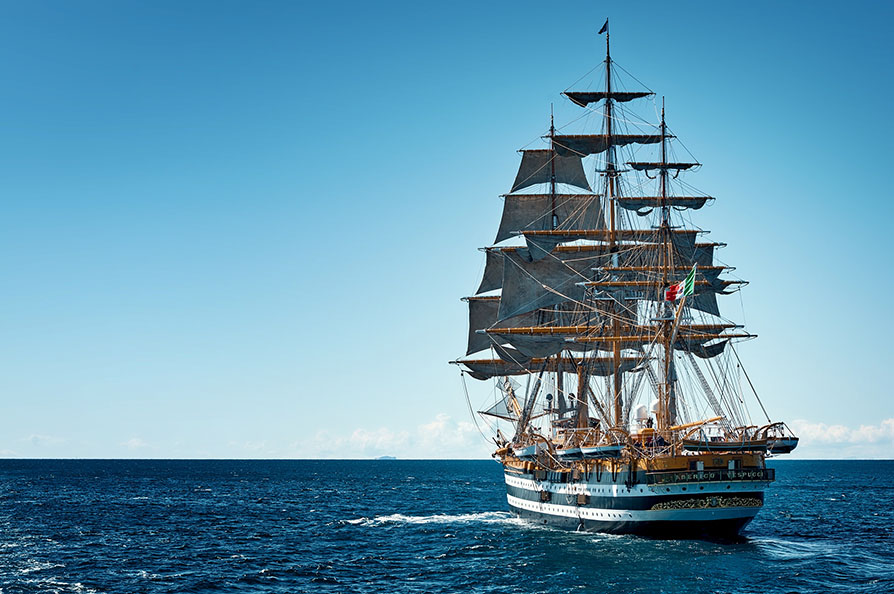 (Photo: Marina Military)
(Photo: Marina Military)

